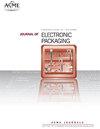利用机器学习对大量球栅阵列芯片底部填充物空洞的相关性研究
IF 2.2
4区 工程技术
Q3 ENGINEERING, ELECTRICAL & ELECTRONIC
引用次数: 1
摘要
本文研究了球栅阵列(BGA)芯片封装在不同参数设置(如芯片传送速度、阀门压力、温度和点胶模式复杂化)下的欠注工艺中的空洞问题。研究发现,阀门压力是造成大量 BGA 芯片空洞的主要原因,在阀门喷嘴变形的支持下,精确度达到了 88.9%。此外,研究结果表明,焊球阵列排列的不对称会产生赛车效应,TSAM BGA 芯片实验与模拟之间的百分比差异在 0.089% 至 3.65% 之间。本文章由计算机程序翻译,如有差异,请以英文原文为准。
Correlation Study On Voiding in Underfill of Large Quantity Ball Grid Array Chip Using Machine Learning
This paper investigates voiding issues in the underfilling process of ball grid array (BGA) chip packages under various parameter settings such as chip conveyor speed, valve pressure, temperature, and dispense pattern complicate. The study identifies valve pressure as the primary cause of voiding in large quantity BGA chips, achieving 88.9% in accuracy, supported with the deformation of the valve nozzle. Additionally, the findings reveal that racing effects occurs due to asymmetry of the solder ball array arrangement with percentage difference between the TSAM BGA chips experiments and its simulation counterparts in the range of 0.089% to 3.65%.
求助全文
通过发布文献求助,成功后即可免费获取论文全文。
去求助
来源期刊

Journal of Electronic Packaging
工程技术-工程:电子与电气
CiteScore
4.90
自引率
6.20%
发文量
44
审稿时长
3 months
期刊介绍:
The Journal of Electronic Packaging publishes papers that use experimental and theoretical (analytical and computer-aided) methods, approaches, and techniques to address and solve various mechanical, materials, and reliability problems encountered in the analysis, design, manufacturing, testing, and operation of electronic and photonics components, devices, and systems.
Scope: Microsystems packaging; Systems integration; Flexible electronics; Materials with nano structures and in general small scale systems.
 求助内容:
求助内容: 应助结果提醒方式:
应助结果提醒方式:


